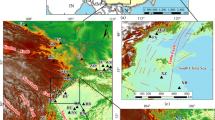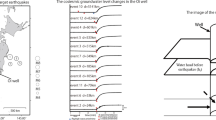Abstract
Seismic stress may cause changes in the hydraulic characteristics of aquifers and corresponding changes in the movement state of the groundwater flow. In this study, based on the theoretical relationship between the tidal response of the well water level and an aquifer’s hydraulic characteristics, the hydraulic parameters of an observed aquifer in the Chongqing area are estimated through the tidal response of the well water level, and the influence of the Wenchuan earthquake on the hydraulic characteristics of the aquifer and the movement of the groundwater is discussed. The results showed that the groundwater near well DZ was mainly controlled by horizontal flow accompanied by extremely weak vertical leakage, and the hydraulic conductivity of the target aquifer calculated using the tidal radial flow model was basically consistent with the results of previous pumping tests. Vertical and horizontal flow coexist in the aquifer system near wells BB and BN, and the specific leakage can be obtained using the mixed aquifer model. The intense tectonic static stress caused by the Wenchuan earthquake resulted in obvious tensile deformation of the aquifers near these three wells, which became the main reason for the changes in the well water level and the enhanced vertical leakage. In addition, the rise in the water level in well BN may have been related to its artesian characteristics and hydrogeological conditions. This article deepens our understanding of the influence of seismic stress loading on groundwater flow in regional aquifers.












Similar content being viewed by others
References
Bower, D. R. (1983). Bedrock fracture parameters from the interpretation of well tides. Journal of Geophysical Research. https://doi.org/10.1029/JB088iB06p05025
Brodsky, E. E., Ma, K.-F., Mori, J., & Saffer, D. M. (2009). Rapid response fault drilling past, present, and future. Scientific Drilling, 8, 66–74.
Cooper, H. H., Bredehoeft, J. D., Papadopulos, I. S., & Bennett, R. R. (1965). The response of well-aquifer systems to seismic wave. Journal of Geophysical Research, 70, 3915–3926.
Cutillo, P. A., & Bredehoeft, J. D. (2011). Estimating aquifer properties from the water-level response to earth tides. Ground Water, 49(4), 600–610.
Doan, M. L., Brodsky, E. E., Prioul, R., & Signer, C. (2006). Tidal analysis of borehole pressure: A tutorial. University of California.
Doodson, A. T., & Warburg, H. D. (1941). Admiralty manual of tides. HMSO.
Elkhoury, J. E., Brodsky, E. E., & Agnew, D. C. (2006). Seismic waves increase permeability. Nature, 441(29), 1135–1138. https://doi.org/10.1038/nature04798
Faoro, I., Elsworth, D., & Marone, C. (2012). Permeability evolution during dynamic stressing of dual permeability media. Journal of Geophysical Research: Solid Earth, 117, B01310. https://doi.org/10.1029/2011JB008635
Gao, X., Sato, K., & Horne, R. N. (2020). General solution for tidal behavior in confined and semiconfined aquifers considering skin and wellbore storage effects. Water Resources Research, 56, e2020WR027195. https://doi.org/10.1029/2020WR027195
He, A., & Singh, R. P. (2019). Groundwater level response to the Wenchuan earthquake of May 2008. Geomatics, Natural Hazards and Risk, V, 10(1), 336–352. https://doi.org/10.1080/19475705.2018.1523236
He, A., Singh, R. P., Sun, Z., Ye, Q., & Zhao, G. (2016). Comparison of regression methods to compute atmospheric pressure and earth tidal coefficients in water level associated with Wenchuan Earthquake of 12 May 2008. Pure and Applied Geophysics, 173, 2277–2294. https://doi.org/10.1007/s00024-016-1310-3
Hsieh, P. A., & Bredehoeft, J. D. (1987). Determination of aquifer transmissivity from Earth tide analysis. Water Resources Research, 23(10), 1824–1832.
Lai, G. J., Ge, H. K., Xue, L., et al. (2014). Tidal response variation and recovery following the Wenchuan earthquake from water level data of multiple wells in the nearfield. Tectonophysics, 0040–1951, 619–620. https://doi.org/10.1016/j.tecto.2013.08.039
Lan, S. S., Gu, H. B., & Liu, Y. (2021). Changes in groundwater level and tidal response caused by the Wenchuan earthquake, China. Hydrogeology Journal. https://doi.org/10.1007/s10040-021-02302-6
Liao, X., Wang, C. Y., & Liu, C. P. (2015). Disruption of groundwater systems by earthquakes[J]. Geophysical Research Letters, 42(22), 9758–9763.
Liu, C. Y., Chia, Y., Chuang, P. Y., Chiu, Y. C., & Tseng, T. L. (2018). Impacts of hydrogeological characteristics on groundwater-level changes induced by earthquakes. Hydrogeology Journal, 26(2), 451–465.
Lv, Y., Luo, S., Fan, X., et al. (2011). Research on the distribution and enrichment regularity of red beds confined water in Chongqing City [J]. China Rural Water and Hydropower, 2010(09), 26–29+38. (in Chinese with English abstract). Earthquake monitoring records of Chongqing[M].Beijing:Seismological Press, 2011.
Manga, M., & Brodsky, E. (2006). Seismic triggering of eruptions in the far field: Volcanoes and geysers. Annual Review of Earth and Planetary Sciences, 34(1), 263–291. https://doi.org/10.1146/annurev.earth.34.031405.125125
Manga, M., Beresnev, I., Brodsky, E. E., Elkhoury, J. E., Elsworth, D., Ingebritsen, S., Mays, D. C., & Wang, C. Y. (2012). Changes in permeability caused by transient stresses: field observations, experiments, and mechanisms. Reviews of Geophysics, 50, RG2004. https://doi.org/10.1029/2011RG000382
Merritt, M. L. (2004). Estimating Hydraulic properties of the Floridan aquifer system by analysis of earth-tide, ocean-tide, and barometric effects. FloridaRep.
Montgomey, D. R., & Manga, M. (2003). Streamflow and water well response to earthquakes. Science, 300, 2047–2049. https://doi.org/10.1126/science.1082980
Quilty, E. G., & Roeloffs, E. A. (1997). Water-level changes in response to the 20 December 1994 earthquake near Parkfield, California. Bulletin of the Seismological Society of America, 87(2), 310–317.
Roeloffs, E. A. (1998). Persistent water level changes in a well near Parkfield, California, due to local and distant earthquakes. Journal of Geophysical Research, 103, 869–889. https://doi.org/10.1029/97JB02335
Roeloffs, E. A., & Quilty, E. G. (1996). Water level and strain changes preceding and following the August 4, 1985 Kettleman Hills, California, Earthquake. Pure and Applied Geophysics, 149(1997), 21–60.
Rojstaczer, S. (1988). Determination of fluid flow properties from the response of water levels in wells to atmospheric loading. Water Resources Research, 24(11), 1927–1938.
Shi, Y., Liao, X., Zhang, D., & Liu, C.-P. (2019). Seismic waves could decrease the permeability of the shallow crust. Geophysical Research Letters. https://doi.org/10.1029/2019GL081974
Shi, Z., Wang, C. Y., & Yan, R. (2021). Frequency-dependent groundwater response to earthquakes in carbonate aquifer. Journal of Hydrology, 603, 1–8. https://doi.org/10.1016/j.jhydrol.2021.127153
Shi, Z., & Wang, G. (2014). Hydrological response to multiple large distant earthquakes in the Mile well, China. Journal of Geophysical Research. Earth Surface, 119(11), 2448–2459.
Shi, Z., & Wang, G. (2015). Sustained groundwater level changes and permeability variation in a fault zone following the 12 May 2008, Mw 7.9 Wenchuan earthquake. Hydrological Processes, 29, 2659–2667. https://doi.org/10.1002/hyp.10387
Shi, Z., & Wang, G. (2017). Evaluation of the permeability properties of the Xiaojiang fault zone using hot springs and water wells. Pure and Applied Geophysics, 170(11), 1773–1783. https://doi.org/10.1007/s00024-012-0606-1
Shi, Z., Wang, G., & Liu, C. (2012). Estimating aquifer volumetric strain caused by the 2008 Wenchuan earthquake from tidal effect of groundwater[J]. Acta Seismologica Sinica, 34(02), 215–223. in Chinese with English abstract.
Shi, Z., Wang, G., & Liu, C. (2013). Co-seismic groundwater level changes induced by the May 12, 2008 Wenchuan earthquake in the near field. Pure and Applied Geophysics, 170, 1773–1783. https://doi.org/10.1007/s00024-012-0606-1
Sun, X., Shi, Z., & Xiang, Y. (2020). Frequency dependence of in situ transmissivity estimation of well-aquifer systems from periodic loadings. Water Resources Research, 56, 202. https://doi.org/10.1029/2020WR027536
Sun, X., Wang, G., & Yang, X. (2015). Coseismic response of water level in Changping well, China, to the Mw 9.0 Tohoku earthquake. Journal of Hydrology, 531, 1028–1039.
Sun, X., Xiang, Y., & Shi, Z. (2019a). Changes in permeability caused by two consecutive earthquakes-insights from the responses of a well-aquifer system to seismic waves. Geophysical Research Letters, 46(10), 367–310. 374.
Sun, X., Xiang, Y., Shi, Z., Hu, X., & Zhang, H. (2019b). Sensitivity of the response of well-aquifer systems to different periodic loadings: A comparison of two wells in Huize, China. Journal of Hydrology, 572, 121–130.
Tamura, Y., Sato, T., Ooe, M., et al. (1991). A procedure for tidal analysis with a Bayesian information criterion. Geophysical Journal International, 104(3), 507–516. https://doi.org/10.1111/j.1365-246X.1991.tb05697.x
Wakita. (1975). Water wells as possible indicators of tectonic strain. Science, 189(4202), 553–555. https://doi.org/10.1126/science.189.4202.553
Wang, C. M., Che, Y. T., Wan, D. K., et al. (1988). Study of micro-behavior of groundwater (pp. 17–18). Seismological press.
Wang, C.-Y., Michael, M., Douglas, D., & Alexander, W. (2004). Streamflow increase due to rupturing of hydrothermal reservoirs: Evidence from the 2003 San Simeon, California, Earthquake. Geophysical Research Letters. https://doi.org/10.1029/2004GL020124
Wang, C. Y., Chia, Y. P., Wang, P. L., et al. (2009). Role of S waves and Love waves in coseismic permeability enhancement. Geophysical Research Letters. https://doi.org/10.1029/2009GL037330
Wang, C. Y., Doan, M. L., Xue, L., & Barbour, A. J. (2018). Tidal response of groundwater in a leaky aquifer—Application to Oklahoma. Water Resources Research, 54, 8019–8033. https://doi.org/10.1029/2018WR022793
Weaver, K. C., Doan, M.-L., Cox, S. C., Townend, J., & Holden, C. (2019). Tidal behavior and water-level changes in gravel aquifers in response to multiple earthquakes: A case study from New Zealand. Water Resources Research, 55, 1263–1278. https://doi.org/10.1029/2018WR022784
Yan, R., Wang, G. C., Ma, Y. C., et al. (2020). Local groundwater and tidal changes induced by large earthquakes in the Taiyuan Basin, North China from well monitoring. Journal of Hydrology, 582, 1–9. https://doi.org/10.1016/j.jhydrol.2019.124479
Yan, R., Wang, G., & Shi, Z. (2016). Sensitivity of hydraulic properties to dynamic strain within a fault damage zone. Journal of Hydrology, 543, 721–728.
Yang, Q. Y., Zhang, Y., Fu, L. Y., et al. (2021). Vertical leakage occurred after an earthquake: suggestions for utilizing the mixed flow model. Lithosphere. https://doi.org/10.2113/2021/8281428
Zhai, G., Shirzaeia, M., Manga, M., et al. (2019). Pore-pressure diffusion, enhanced by poroelastic stresses, controls induced seismicity in Oklahoma. Proceedings of the National Academy of Sciences, 116(33), 16228–16233.
Zhang, Y., Wang, C.-Y., Fu, L.-Y., & Yang, Q.-Y. (2021). Are deep aquifers really confined? Insights from deep groundwater tidal responses in the North China Platform. Water Resources Research, 57, e2021WR030195. https://doi.org/10.1029/2021WR030195
Zhu, A.-.Y., & Wang, C.-Y. (2020). Response of leaky aquifers to Earth tides – Interpreted with numerical simulation. Journal of Hydrology, 581, 124458. https://doi.org/10.1016/j.jhydrol.2019.124458
Funding
The original water level data used in this article are from the National Earthquake Precursory Network Center. This work was supported by the Beijing Natural Science Foundation of China (8222003), National Natural ScienceFoundation of China (41877205) and National Natural Science Foundation of China (41807180).
Author information
Authors and Affiliations
Contributions
All authors contributed to the study conception and design. Material preparation, data collection and analysis were performed by SL, KZ, HG, WL, PQ. The first draft of the manuscript was written by SL and KZ, and all authors commented on previous versions of the manuscript. All authors read and approved the final manuscript.
Corresponding author
Ethics declarations
Conflict of Interest
The authors have no relevant financial or non-financial interests to disclose.
Additional information
Publisher's Note
Springer Nature remains neutral with regard to jurisdictional claims in published maps and institutional affiliations.
Supplementary Information
Below is the link to the electronic supplementary material.
Rights and permissions
Springer Nature or its licensor holds exclusive rights to this article under a publishing agreement with the author(s) or other rightsholder(s); author self-archiving of the accepted manuscript version of this article is solely governed by the terms of such publishing agreement and applicable law.
About this article
Cite this article
Lan, S., Zhao, K., Gu, H. et al. Changes in the Hydraulic Characteristics in Chongqing Related to the Wenchuan Earthquake. Pure Appl. Geophys. 179, 3767–3783 (2022). https://doi.org/10.1007/s00024-022-03139-0
Received:
Revised:
Accepted:
Published:
Issue Date:
DOI: https://doi.org/10.1007/s00024-022-03139-0




